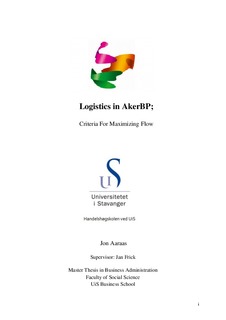| dc.description.abstract | Following the merger of Det Norske Oljeselskap and BP Norge in September 2016, the merged company AkerBP encountered a strategic choice concerning their logistics chain. The two merged companies carried each their solution to land transportation, where the fundamental difference between the two stem from contractual terms of delivery, formalized as Incoterms. The Incoterms determine responsibility for the parties of risk, cost and insurance, and where each of these responsibilities are transferred from seller to buyer. Implications on operations of choosing either Incoterms may seem obvious. However, the decision yields relevance for a wider range of aspects in the chain, and on the ability of AkerBP to successfully carry out their goal of flow efficiency in accordance with Lean-principles.
The purpose of the thesis was to provide AkerBP with relevant criteria for success in reaching their goals. The criteria should facilitate strong operational results, flow efficiency, support continuous improvement in the chain and retain cost-control. Action research was utilized to carry out the research. The approach allowed for application of multiple methods. Data was collected through interviews with internal and external stakeholders, as well as retrieved from internal resources. A mapping of the chain and a cause – and – effect analysis was subsequently conducted. The data uncovered an organizational bottleneck upon reception of goods at the offshore base, and wastes following from Lean-theory were addressed.
The analysis found four main criteria facilitating success. As a basis to reduce waste and enable flow efficiency, the analysis found Incoterms FCA should be utilized. The next critical criteria found was implementation of interfaces and integration between the planning systems used in the chain. Most critical is an interface between the planning system and the ERP-system. Consistent communication of reference/documentation requirements was found to need attention. Moreover, the analysis found a close collaboration with the freight forwarder to be of great importance. Such a collaboration enables meeting the fourth criteria. The criteria involve moving the barrier for shipping goods not compliant from the offshore base back to dispatch from the vendor. Together with the barrier, a feedback loop to enhance results should be implemented, supporting accelerated learning and reduction of time wasted later in the chain.
Together, the criteria makes possible flow at the pull of the customer, facilitates learning and enables continuous improvement by involved stakeholders. | nb_NO |
